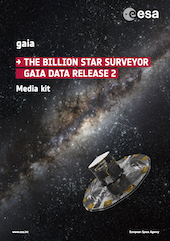ESA Science & Technology - Publication Archive
Archive intro text - publications
A special issue of Astronomy & Astrophysics on the Gaia data release 1 was published in November 2016. Links to the papers in that issue can be found here.
A special issue of Astronomy & Astrophysics on the Gaia data release 2 was published in April 2018. Links to the papers in that issue can be found here.
Below is a selection of publications related to the Gaia mission.
Publication archive
Publication archive
This media kit contains background information about the Gaia mission. It has been prepared to accompany Gaia Data Release 2.
Contents:
Gaia – the billion star surveyor
Fast facts
Mapping the Galaxy with Gaia
Gaia's second data release – the Galactic census takes shape
Caveats and future releases
Science with Gaia's new data
Science highlights from Gaia's first data release
Making sense of it all – the role of the Gaia Data Processing and Analysis Consortium
Where is Gaia and why do we need to know?
From ancient star maps to precision astrometry
Appendices: Resources, Information about the press event, Media contacts
File updated 24 April 2018, to correct typo.
To download the pdf file click on the image or on the link to publication below.

